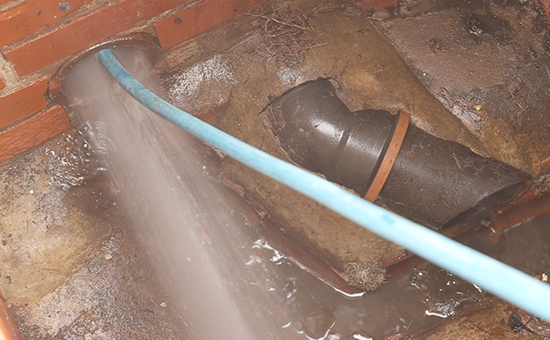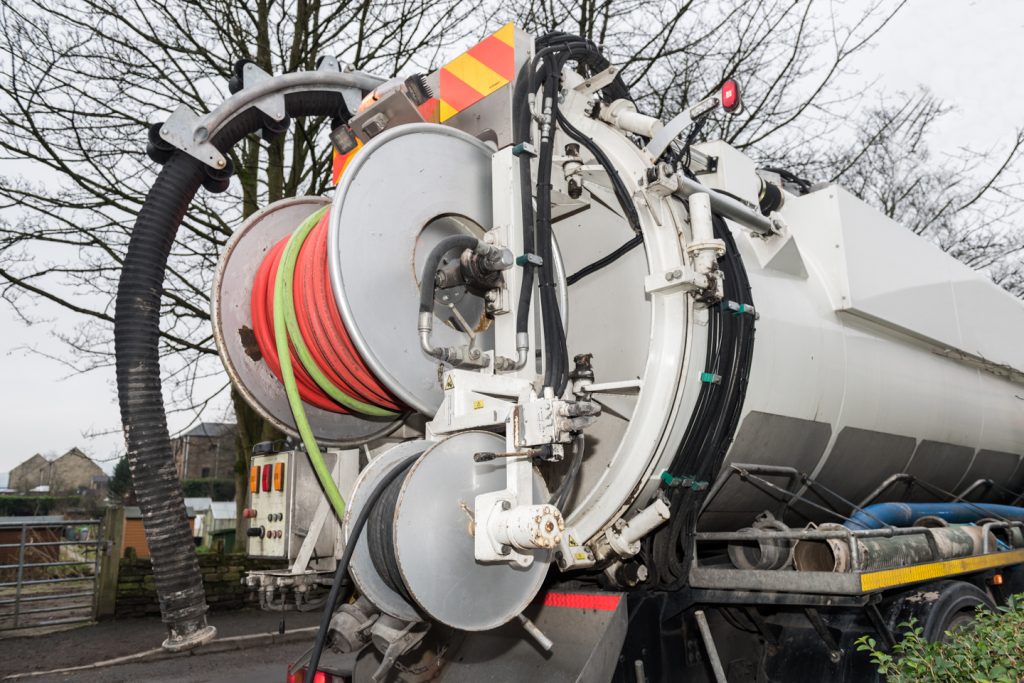December 15, 2025
Catalyst colleagues share Christmas cheer with local families
Colleagues at Catalyst Services UK have helped the company provide Christmas gifts for families,...
Drain jetting is vitally important to the safe and effective delivery of drainage services. This Catalyst Services UK guide is designed to give service users an overview of drain jetting, helping them to better understand what to expect from drainage contractors.
Drain jetting, also known as sewer jetting, is the process of pumping water under pressure into drain and sewer pipes to clean them and remove blockages. In effect, a jet of water – hence the term water jetting – is used to break up unwanted material.
The material can then be removed from the pipe, leaving it clear. Or, because it has been broken up, it will be carried along the pipe by the wastewater in it.

Drain jetting is carried out by connecting a powerful water pump to a flexible hose with a nozzle at the end of it. The hose is guided into the drain pipe. The pump is them switched on to force water through the hose and out of the nozzle into the pipe.
The power of the water jet is determined by the pressure the water is under and the volume of water flowing out of the nozzle, referred to as a water flow rate.
For standard water jetting, pressures can rise to 4,000 pounds per square inch (psi) or 275 bar, with no limit on flow rate.
However, to remove very tough material from drains and sewers – for example concrete – water pressures of up to and over 12,000 psi (827 bar) can be used. Drain jetting at such high pressures is very specialised and can only be carried out by very skilled operatives (See: Can drain jetting damage my drains?).
Drain jetting has three main purposes:
Find out more about drain jetting services. Call 0800 870 8080. Email [email protected]
Drain jetting is essential to maintain drain and sewer systems properly. Most pipes in drainage systems are buried underground. Even drain pipes in buildings are hard to reach.
Drain jetting is a remote access method for keeping them clean and free from blockages. If a drain or sewer pipe becomes blocked, the only alternative may be to excavate it and remove the blocked section.
This would cause significant disruption, take much longer for blockages to be cleared, and would be much more costly than drain jetting.
Being underground, drains and sewers can become filled with tree and shrub roots. This process is called root infestation. It happens when very small roots grow through pipe cracks and displaced pipe joints, then multiply and expand inside pipes. A common method for removing these root infestations is by drain jetting.
Drain jetting has become increasingly important because drainage systems are used more intensively, especially in towns and cities.
Also modern lifestyle choices increase the risk of blockages. For example, large volumes of fats, oils and grease – known as FOG – are wrongly disposed of down sinks.
Residues from washing powders, detergents, shampoos, and soaps (gels and bars) can also build up in pipes, reducing their diameters and, eventually, blocking them. Also, items such as wet wipes and sanitary products are wrongly flushed down toilets. Both of these behaviours greatly increase the risk of blockages, which require them to be drain jetted.
Types of drain jetting are defined largely by the size of the pumps and hose systems used – and also by the types of nozzles attached to hoses.
Most drain blockages are cleared using drain jetting equipment installed in a van – known as a van pack. This contains a pump, a water tank, a reel of hose, and a selection of jetting nozzles.
Different nozzles can be selected, depending on the design and condition of the pipe, and the cleaning or blockage removal task that needs to be undertaken (See: Drain jetting nozzles, below).
The van also usually carries CCTV drainage survey cameras.
To remove bigger blockages and to clean pipes over longer lengths and with larger diameters, a more powerful drainage vehicle, called a jet vac tanker, may be needed.
These HGVs have larger pumps and wider diameter hoses to allow them to deliver water jets with higher flow rates. This increases the force of the water jets, which means they can:
Jet vac tankers can also suck up blockage material with vacuumation equipment, reducing the chance of further blockages, and minimising pollution risks.
The most powerful jet vac tankers are used to remove large blockages, including fatbergs. Fatbergs contain FOG and other items, usually wet wipes, and can block long lengths of sewer pipe.


Jetting nozzles play a crucial role in the drain jetting process. The design of the nozzle determines the type of jet created and its pressure. In simple terms, for a given amount of water pumped through the hose, the smaller hole in the jetting nozzle, the higher the pressure.
So, a fine nozzle (such as a pin jet, see below) will generate a high pressure (low flow rate) drain jet needed to remove concrete from a pipe. But a plough jet with a high flow rate (but lower water pressure) is used to remove large volumes of silt from a pipe.
Drain jetting is safe if it is done properly. The main risk is caused by the pressure and flow rate of the water jets. Water under pressures as low as 100 psi (7 bar) can penetrate human skin.
At higher pressures, these injuries, called fluid injection injuries, can be catastrophic, even fatal. They can be caused by an operative losing control of the hose and the water jet hitting their body, or by a hose bursting, releasing an unexpected jet of water.
Research commissioned by the Water Jetting Association found a second serious risk was an uncontrolled hose striking an operative’s head or body, causing a major trauma injury.
The WJA has created a water jetting injury treatment algorithm based on the research that provides best practice advice, from first response to post-treatment rehabilitation, for treatment of water jetting injuries.
Therefore, it is very important that drain jetting is done by people using the right equipment, including specialist personal protective equipment (PPE), plus the right training, qualifications and experience.
Drain jetting is carried out from access points into pipes. These can be manholes, gullies, rodding eyes, or excavations. This creates slip, trip and fall hazards. In some cases, safety procedures must be used that are similar to those used when working at height. Working on drains and sewers also presents significant hygiene risks.
Drain jetting is a specialist process and should not be attempted by householders or business owners. Trying to carry out drain jetting with equipment not designed for the task is very unlikely to clear blockages or clean drain pipes. In fact, it is more likely to make blockages worse or create new blockage problems.
Drain jetting should only be carried out by drain cleaning and unblocking contractors who have the right skills, qualifications, experience and equipment to carry out the task safely and to a high standard.
The most widely used training courses for drain jetting are provided by the Water Jetting Association, the member body for the UK water jetting industry. Its water jetting courses are accredited by City & Guilds.
For drainage engineers to hold a WJA water jetting card and certificate, they must pass a one-day WJA Safety Awareness course and then at least one of four one-day WJA practical modules, usually selecting the one for drain and sewer jetting.
The National Association of Drainage Contractors also provides a one-day high pressure water jetting training course, certified by EU Skills, which covers all aspects of the safe use of high pressure water jetting units.
The WJA has a Code of Practice for the safe use and working of water jetting equipment in drains and sewers, known as the Red Code. This is recognised by the Health and Safety Executive as setting the approved standard for drain jetting in the UK. It is also used by drainage contractors and regulatory agencies in many other countries to guide the use of drain jetting equipment.
Drain jetting equipment is very powerful. If it is not used properly, it can damage drain and sewer pipes, especially if they have already been weakened by being damaged or displaced.
Pipes have maximum water pressure allowances depending on the material they are made from – for example, clay, plastic and metal. A jetting nozzle left static in one place in the pipe for a period of time can also cause damage to the pipework.
Drainage engineers use their skill, experience and set procedures to ensure the drain jetting they carry out does not damage pipes in this way.
There are five common ways to clean or unblock drain pipes and sewers if drain jetting is not to be used.
The drain rod has a plunger cup on the end that can be moved backwards and forwards, creating a vacuum pressure that, in most cases, dislodges blockages and allows the material to be flushed through the pipe.
The risk with drain rodding is that the rods, themselves can become stuck in pipes, creating an even worse blockage problem.
This method is commonly used to clean drainage systems inside large buildings and in wastewater downpipes where using drain jetting risks water escaping through lateral connections, causing internal flooding.
Yes it is. Because drain jetting is a remote access method to maintain pipes, it uses less effort and energy than is needed to carry out an excavation.
Because drain jetting is such a powerful process, blockages can be removed relatively quickly, so only a relatively small volume of water is used. Also, no chemicals are added to the jetting water.
Jet vac tankers can suck up blockage material, removing substances like FOG that are a pollution risk and could cause further blockages. Also, some jet vac tankers, called recyclers, can filter and reuse this water, reducing the amount of water needed to carry out drain jetting.
All material sucked up by jet vac tankers, or taken out of drains by van pack drainage engineers, during drain jetting is taken to an authorised waste site for safe and legal disposal.
Where blockage material is not removed during drain jetting, it eventually reaches a sewage treatment works where sophisticated equipment is used to remove it as part of the water cleaning process.
Contact Catalyst Services UK today.
Helping business and domestic customers every day of the year
December 15, 2025
Catalyst colleagues share Christmas cheer with local families
Colleagues at Catalyst Services UK have helped the company provide Christmas gifts for families,...
December 12, 2025
Gemma makes it a double with second Kudos of Year Award
Property claims handler Gemma has completed an amazing double by winning the Catalyst Services...
December 11, 2025
Insurance providers urged to join national body to meet the subsidence challenge
Effective communication will be vital if the insurance claims industry is to respond decisively...